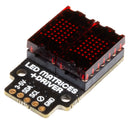LED Dot Matrix Breakout
by Pimoroni










Get retro with this pair of 5x7 LED micro dot matrices - available in green or red!
We've always loved these old school LTP305 LED matrices (first developed in the 1970s!) and we thought it was high time we made a breakout with them. You get two 5x7 displays (plus a decimal point) and an LED driver, mounted on a Breakout Garden compatible I2C breakout. This breakout is preassembled, so there's no need for tiny soldering (unless you want to attach the breakout to a header).
This breakout is perfect for readouts that involve two numbers or letters - like countdown timers, percentage readouts, or country codes. You can also use the LEDs for graphical displays - a tiny graphic equaliser perhaps, or creepy light up eyes for a very small pumpkin! Their weird science vibe makes them great for cosplay and wearable projects too.
You can attach this breakout to your Pi's GPIO directly or via a breadboard with the included headers, but it's also compatible with our fancy solderless Breakout Garden, which makes it easy to use several different breakouts at the same time.
Features
- IS31FL3730 LED matrix driver chip
- 2x LTP-305 green or red LED matrices
- 2x M2.5 mounting holes
- I2C interface (default address: 0x61)
- 3V to 5V compatible
- Reverse polarity protection
- Raspberry Pi-compatible pinout (pins 1, 3, 5, 7, 9)
- Compatible with all models of Raspberry Pi (Python library)
- Compatible with Raspberry Pi Pico (C++/MicroPython libraries)
Kit includes
- Microdot Breakout
- 1x5 straight male header
- 1x5 right angle female header
We've designed this breakout board so that you can solder on the piece of right angle female header and pop it straight onto the bottom left 5 pins on your Raspberry Pi's GPIO header (pins 1, 3, 5, 7, 9).
Software
We've put together a Python library with examples showing you how to control these LED displays. One of the examples is eyes 👀
You can also use this breakout with Raspberry Pi Pico and other RP2040 boards, using C++ or Pirate brand MicroPython.
Notes
- The default I2C address is 0x61. You can change this to 0x63 by cutting the trace on the back of the breakout. If you cut the trace and solder the bridge the address will be 0x62 - so it's possible to use up to three of these breakouts at the same time.
- Dimensions: approx 32.1mm x 20.8mm x 9.1mm (LxWxH)
We no longer stock this product
It's sad to say goodbye but sometimes we have to retire products to make way for new things.
Need a large quantity or a customised version? We may be able to help! Contact wholesale@pimoroni.com to discuss a custom build.
Shop with confidence – we've been serving the hobbyist electronics, Maker, and retro gaming communities since 2012.
- Satisfaction or refund guarantee
- Worldwide shipping via mail or courier
- 57,000+ customer reviews
- Secure website and payments
